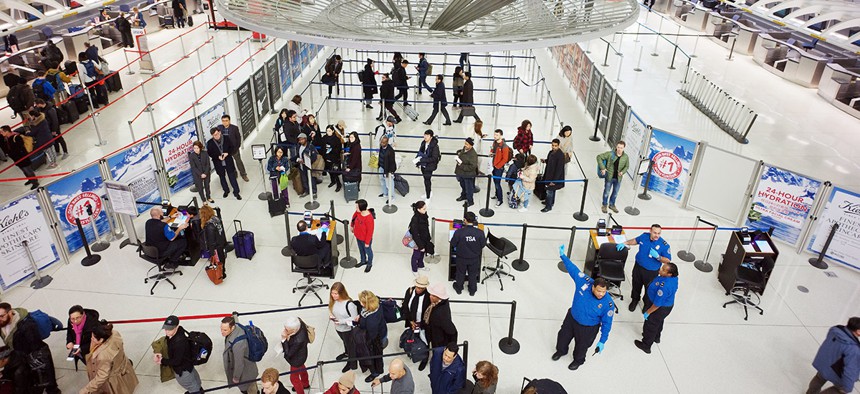DHS Awards $1.5M for Algorithms to Accelerate Airport Security

Passengers stand in line as they wait to pass through a TSA security checkpoint at JFK International Airport in New York. Mark Lennihan/AP File Photo
The challenge's goal was to reduce false alarms and pat-downs.
The Homeland Security Department awarded $1.5 million to the top eight finishers in a competition to design machine-learning algorithms that get people through airport security faster than ever.
Participants worked to build an application that detects contraband on air travelers more quickly and accurately than existing security scanners. The contest, co-funded by the Transportation Security Administration and Homeland Security Science and Technology Directorate, comes as part of the agency’s broader efforts to streamline and upgrade the airport security process.
“The Passenger Screening Algorithm Challenge was an innovative way to challenge a broad community to solve a difficult problem,” said John Fortune, DHS S&T Apex Screening at Speed program manager. “Better [automated target recognition] algorithms directly contribute to the passenger experience, reducing the need for pat-downs and accelerating the screening process.”
Jeremy Walthers of Rockville, Maryland, won the overall competition, taking home $500,000 for developing a system that uses a slew of deep learning models to analyze images from different angles. Second and third place participants received cash prizes of $300,000 and $200,000, respectively, and other top finishers won $100,000 each.
The contest comes as part of S&T’s Apex Screening at Speed program, which aims to overhaul the way TSA clears passengers and luggage before boarding a plane. In addition to creating algorithms to speed up passenger scanning and reduce false alarms, the program includes a number of hardware upgrades and could one day expand the clearance process beyond the security checkpoint to the entire airport.
The algorithms developed through the competition would provide TSA agents with more accurate data on what objects are going through scanners, helping them better discern the difference between a bomb and, say, an antique clock. S&T next plans to experiment with the algorithms on additional image sets with the intention of eventually integrating them within the next-generation of scanning equipment.
“Our vision for the program is to … improve aviation security from curb to gate,” Fortune said in a conversation with Nextgov. “We’re dealing with an adaptive, emerging adversary, and the threat space is not constant,” so it’s essential to equip TSA with an equally “dynamic, adaptive aviation screening system that can deal with whatever adversaries throw us.”






